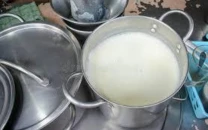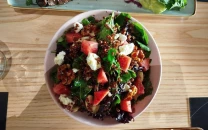Coconut: The all-in-one fruit
Due to its health benefits the coconut is considered a nutritious food, hardly any fruit is as multipurpose as it.

Coconut: The all-in-one fruit
Coconut palm is classified as a tree but it is a woody perennial trunk that lacks bark, branches and secondary growth. It is a source of food, shelter, firewood and tools. For Pacific islanders, the coconut palm is the tree of life. Production of charcoal from the trunk proved useful during World War I. At that time, gas mask filters were made using granules of this charcoal. Meanwhile, its leaves are used to make baskets, hats, mats and brooms, while the roots are used to make medicines, mouthwashes and dyes.
A mature coconut tree with the height of 65 to70 feet can yield 50 to 80 coconuts per year. Home gardeners use traditional methods, such as adding fish bone meal and salt in the soil for picking more nuts.
Cultural significance
In traditional Asian cultures, the fruit has spiritual, religious and commercial value. It has featured in epic stories for more than 4,000 years. In Indian mythology, the three holes or perforations on top of the fruit are considered the eyes of Lord Shiva. Offering it to the bride, at the opening of a new house and gifting to the mother-to-be are marked as a symbol of good omen. Some say that women should eat coconut flesh during pregnancy to give birth to fair-complexioned babies. Children are encouraged to drink coconut water to become tall. Although with any scientific basis, such tales have been passed on successfully from generations. In Fiji, native people make rope or string from coconut husk to put on their chief’s grave.
The Philippines celebrates National Coconut Week, a trade fair and festivals annually to cater to business opportunities and to pay “tribute of honour and thanksgiving for the blessings and benefits derived from the industry to establish continuing awareness of its lasting importance to our national life,” says the coconut authority Philippines’s administrator, Oscar G Garin.
Medicinal use
Labelled as a secret of a long and healthy life, coconuts have a long drawn-out history of preventing chronic illnesses. Contemporary medical science also admits the efficacy of coconuts. Research conducted by the Universities of Kerala, Nigeria and Norway found coconut’s flesh, oil and water useful for the treatment of HIV, cancer, diabetes and digestive illnesses.
The void in the centre of the unripe coconut contains sweet and nutritious water. This naturally filtered juice is a source of refreshment during hot summer days. An excellent source of minerals and vitamins, coconut reduces acidity of the stomach. During World War II, doctors used coconut water to overcome shortage of intravenous (IV) solution.
The edible white coconut flesh contains high amounts of saturated fats, iron, phosphorus and zinc. It has more protein than a banana or an apple. The approximate nourishing value of a fresh coconut is about 283 calories, which includes protein 2.7g, carbohydrate 12.2g, fat 26.8g, fibre 7.6g, iron 1.9mg and selenium 8.1 mcg. The dried form (khopra) contains 60 to 70 per cent coconut oil.
According to recent studies, lauric acid, a constituent of coconut oil, is found to be helpful in the treatment of influenza virus, pneumonia and measles. The acid is antiviral and increases immune system. It helps reduce weight and lowers the risk of heart attack. It is beneficial for hair and cures fungal infection as well as skin rashes. In Jamaica coconuts are used to treat tumours.
Cosmetic companies in developed countries use coconut oil as their main ingredient for making shampoos and conditioners (for shiny and silky hair), lip balm (to protect lips from dryness) and foot cream (for cracked heels).
Cuisines
Adding coconuts in dried form makes dishes such as korma, zarda, koftay and chicken curries rich in flavour and colour. Grated coconut is treated with hot water to yield coconut milk. This milk is often used as an alternative of milk in the making of ice cream and custard. Kernel is added in vegetables dishes to enhance flavour. Desiccated and grated khopra is combined with mint, green chillies, cumin seed and cloves of garlic to make delicious chutney. Coconut milk is an essential ingredient in Sri Lankan cuisines such as hoppers, a crispy bowl shaped bread. This bread is made by mixing rice flour, coconut milk and yeast. In Thailand, a special variety of rice known as sticky rice or Neuw is soaked overnight and then steamed. Pouring of hot coconut milk gives the rice a soggy texture. During hot summer days it is topped with ripe mango. This dish is known as Kow Neuw Mamuang.
Some major coconut producers are Indonesia, Philippines, Sri Lanka and India. Its commercial value inspires coconut growing countries to acquire the services of qualified staff and scientists for yielding better crops. One such institute is the Coconut Research Institute of Sri Lanka, established for the sustainable development of the coconut industry.
RECIPE - Coconut Cupcakes
Ingredients:
• 175g softened unsalted butter
• 120g castor sugar
• 2 large eggs (beaten)
• 25g cocoa powder
• 50g desiccated coconut
• 150g plain flour
• 1 tsp baking powder
• 3 tbsp milk
Frosting:
• 150g mascarpone/ cream cheese
• 1 tbsp icing sugar
• Zest(citrus peel) of 1 lime
• 25g desiccated coconut soaked in a little milk
Method:
• Preheat the oven to 180 degrees and line a muffin tray with paper cases.
• Cream together the butter and sugar in the large bowl until pale and light.
• Add beaten eggs and mix well. Add cocoa powder and coconut.
• Mix the flour and baking powder and fold it to the butter-egg mixture.
• Divide between the paper cases and bake on the middle shelf of the oven for 30 minutes until the cakes are golden and toothpick inserted comes out clean. Remove from the oven and allow cooling.
• To make the frosting, mix the mascarpone/cream cheese, icing sugar and lime zest until smooth. Add coconut. When ready, spread an even layer of the mascarpone mixture over the top of each cake and sprinkle with coconut.
Source: http://www.coconutrecipes.co.uk/coconut-cupcakes/
Published in The Express Tribune, November 14th, 2010.



















COMMENTS
Comments are moderated and generally will be posted if they are on-topic and not abusive.
For more information, please see our Comments FAQ